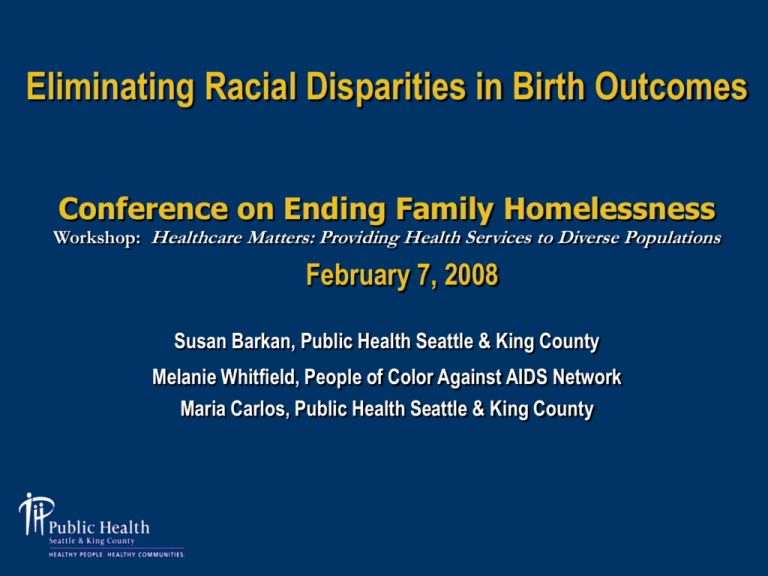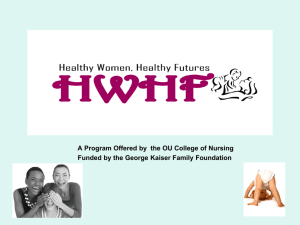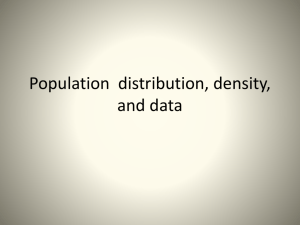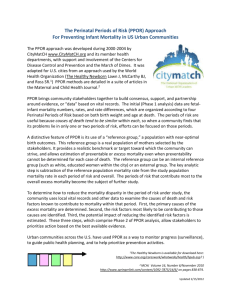Eliminating Racial Disparities in Birth Outcomes by G. Marie Carlos
advertisement

Eliminating Racial Disparities in Birth Outcomes Conference on Ending Family Homelessness Workshop: Healthcare Matters: Providing Health Services to Diverse Populations February 7, 2008 Susan Barkan, Public Health Seattle & King County Melanie Whitfield, People of Color Against AIDS Network Maria Carlos, Public Health Seattle & King County Acknowledgements Susan Barkan Kathy Carson Parent Child Health, Public Health-Seattle & King County Maria Carlos Eva Wong Doctoral Student, Department of Epidemiology, University of Washington Alice Park Mei Castor Urban Indian Health Institute Shira Rutman Jim La Roche Leslie Randall Northwest Portland Area Indian Health Board Leah Henry Tanner Native American Women’s Dialog on Infant Mortality (NAWDIM) Jim Gaudino Oregon State Department of Health Infant Mortality Rates US, Washington State, King County, Seattle Three Year Rolling Average, 1981-2004 12 Seattle Washington State Rate per 1,000 Live Births 10 United States 8 6 2004 Infant Mortality Rates: 4 2 United States (2003): 6 .9 Washington State: 5.5 King County: 4 .4 Seattle: 5.4 King County outside Seattle: 4 .1 King County outside of Seattle King County 0 3 4 5 6 7 8 9 0 1 2 3 4 5 6 7 8 9 0 1 2 3 4 -8 2-8 3-8 4-8 5-8 6-8 7-8 8-9 9-9 0-9 1-9 2-9 3-9 4-9 5-9 6-9 7-9 8-0 9-0 0-0 1-0 2-0 1 8 8 8 8 8 8 8 8 8 9 9 9 9 9 9 9 9 9 9 0 0 0 Contributions to the Overall Decline in Infant Mortality in King County First Steps: Maternity support and expansion of Medicaid coverage of prenatal services Safe Sleep: Back to Sleep Campaign Medical Advances: Neonatal intensive care Behavioral: Decline in use of tobacco, alcohol, unintended pregnancies Infant Mortality Rates by Race/Ethnicity, King County, Three Year Rolling Averages, 1985-2004 Perinatal Periods Of Risk (PPOR) Approach A simple approach. identify gaps in the community. target resources for prevention activities. mobilize the community to action. PPOR guides strategies to improve birth outcomes Prematurity and low birthweight lead to infant mortality. PPOR method gives information that guides community strategies to help infants be born healthy. PPOR Findings WA State, 2000-2004 Infant Health is the highest contributor to preventable FIMR among American Indian/Alaska Natives Maternal Health/Prematurity is the highest contributor among African Americans and the second highest contributor among AI/AN. Maternal Care is the third highest contributor to among AI/AN. Newborn Care is consistently the lowest and is similar for all racial/ethnic groups. Implications/”Opportunity Gaps” Maternal Health/ Prematurity Preconception Health Health Behaviors Perinatal Care + EXPAND STRATEGIES to address social factors giving rise to disparities Infant Health Sleep Position Breast Feeding Injury Prevention Medical Care for Infections and Chronic Conditions Prevalence and Trends in Birth Risk Factors by Race, King County American Indian/ African Americans Alaska Natives % of Births 20002002 Low Birth Weight (< 2500 g) 10.5* Very Low Birth Weight (< 1500 g) 2.2* Preterm (<37 weeks gestation, calc.) 18.9* Multiple Birth (twins, triplets, etc.) 4.1 Mother's Age < 18 4.0* Single Mother 54.1* Late (3rd) or No Prenatal Care 4.8* Inadequate Prenatal Care (Kotelchuck) 19.2* Smoking During Pregnancy 11.1* Alcohol Use During Pregnancy 1.6 Time Trend 19932002 ---- % of Births 20002002 6.6 1.9* 16.9* 3.2 6.4* 58.7* 6.5* 18.8* 19.8* 4.0 Time Trend 19932002 --- -- Whites % of Births 20002002 5.3 0.8 11.9 3.6 1.5 20.5 2.0 7.7 8.0 2.7 Rates and rate ratios followed by an asterisk (*) are statistically significantly higher than the rate for whites. Indicates a statistically significant increase over the period 1993-2002. Indicates a statistically significant decrease over the period 1993-2002. Time Trend 19932002 -- American African Indian/ American: Alaska White Native: Rate White Ratio Rate Ratio (2000-2002) (2000-2002) 2* 2.6* 1.6* 1.2 2.7* 2.6* 2.4* 2.5* 1.4* 0.6 1.3 2.3* 1.4* 0.9 4.2* 2.9* 3.3* 2.4* 2.5* 1.5 How Stress Can Affect Health: Increased cortisol (fight/flight hormones) results in increased cardiovascular function Can lead to high blood pressure, depressed immune function with increased vulnerability to infection, and depression. All of these can contribute to risk of preterm delivery. These stress responses are designed to help us deal with short term threats, but for many, the stressors don’t go away. Long-term, chronic stress does not allow for system recovery and predisposes to adverse health effects Reported Stressful Life Events During Year Before Delivery King County, 1999-2001 African American American Indian/Alask a Native White Changed residence (moved) Argued with partner more than usual 44%* 36%* 53%* 43%* 33% 17% Had bills and couldn't pay Someone close died Close family member ill and hospitalized Separated or divorced from partner Someone close had drinking/drug problem Partner said he didn't want pregnancy 31%* 24%* 24% 20%* 15% 15%* 42%* 25% 22% 19%* 28%* 21%* 14% 15% 24% 5% 13% 8% Husband/partner lost job Mother lost job Mom or partner went to jail Involved in a physical fight Homeless Reported 5 or more stress events 14% 21%* 10%* 7% 11%* 12%* 20%* 15%* 22%* 12%* 15%* 23%* 8% 5% 4% 4% 1% 4% Stress Events Stress factor prevalences followed by an asterisk (*) are statistically significantly higher than the estimate for whites. Data Source: Pregnancy Risk Assessment Monitoring System (PRAMS) Lack of Social Support During Pregnancy by Race/Ethnicity, King County, 1999-2001 40% African American 35% American Indian/Alaska Native 30% White Percent 25% 20% 15% 29% 24% 22% 10% 21% 17% 16% 13% 5% 10% 15% 11% 7% 7% 0% No one to loan No one to help me $50 me if I was sick & in bed Data Source: Pregnancy Risk Assessment Monitoring System (PRAMS) No one to give me a ride to the doctor No one to talk with about my problems INSTITUTIONALIZED RACISM/ Historical Trauma Discrimination • • • • • Health Care Housing Legal System Employment Refused care over IHS status Poverty • • • • • • Abuse Affordable Housing Moving frequently Adequate Education Employment Access to Health Care Perceived as wealthy • • • • Institutional Interpersonal Cycles Substance Internalized Racism • Hopelessness • Self-hatred and blame • Inability to see family/ community as support • Ancestry seen as hindrance to life’s goals STRESS Direct Effects: Endocrine System Response - Increased cortisol levels, decreased immune function, increased vulnerability to infection, trigger onset of labor Indirect Effects: Maternal Behaviors – Smoking, alcohol, substance use, poor nutrition, survival supersedes wellness DISPARITIES IN BIRTH OUTCOME Mayet Dalila, IntraAfrikan Konnections Indigenist model of trauma, coping, and health outcomes for American Indian women (Walters K. 2002) What more needs to be done: Continue support of pregnant women’s health care: prenatal care, MSS/ICM, outreach. Find support for community mobilization efforts Community collaboration around housing, income equity, access to quality education, access to culturally relevant, culturally appropriate health care. . . Decrease the impact of inequalities and racism on women and families through community support. NAWDIM & Brown Sugar Babies What more needs to be done: Continue the PPOR analysis and community engagement process to use the data to target prevention efforts and support the work of the community Need for prevention to focus on preconceptional health, health behaviors, and specialized perinatal care services Sustained need for early and continuous prenatal care services, referral of high-risk pregnancies and good medical management of medical problems Continued need for programs that support infant health such as SIDS prevention, access to a medical home, and injury prevention What You Can Do: Work on adequate housing, income equity, quality education, access to culturally appropriate health & social services. Provide culturally appropriate mental health services for people of color & low-income folks. Get training on undoing institutionalized racism Undoing Institutionalized Racism, People’s Institute for Survival & Beyond PBS Video: Race: The Power of Illusion PBS Video: Unnatural Causes: Is Racism Making Us Sick? (March, 2008) Involve community members, clients, consumers in defining your work. “Injustice anywhere is a threat to justice everywhere.” Martin Luther King, Jr. Thank you!







